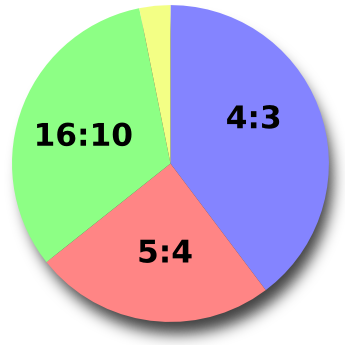It is very easy for us as technologists to loose perspective on what "real users" are using their computers for, and what equipment they have. That's why I was very interested to look at the data for which screen sizes were used to view Ubuntu.com that was posted by Matt Nuzum on the GNOME Usability list today. What can we learn from this data?

The most common resolution used to view the website was 1024x768. This isn't a huge surprise as it is very common resolution, especially for 15" monitors. It seems that most computers today come with a 15" display by default. I then took the data and weighted the area of the screen by the percentage of people using it to try and discover the average screen area. To my surprise it was rather large, 1240x930. Which I think shows that while most people are using 1024x768, we're starting to see that as the low end with most people using higher resolutions. It is important to note that this average size was taken assuming everyone had a 4:3 display, which isn't always the case either.

Personally I've been using widescreen monitors for a while, and I'm addicted. I think it's the way computers should be. But, they've mostly been in more professionally focused laptops and desktops, and not out in the general public. But, looking at the data presented it seems like more and more people are starting to use widescreen displays. Almost one third of displays were widescreen. I think that's interesting as we start to look at usability and design for the desktop. One of the key questions starts to become the handling of panels that are taking up the "long edge" of the display. It is also interesting to note that "odd ratios" either vertical displays or just simply displays that didn't hit these ratios dead on, accounted for roughly 3% of the overall visitors.
I'm not sure if there is any definitive lessons from any of this data other than the most common case was pretty much expected. But I think that it is showing some interesting trends to where we should be thinking for the next generation of desktops. Lastly, here is my derived data if you'd like to check my formulas.
posted Mar 18, 2008 | permanent link